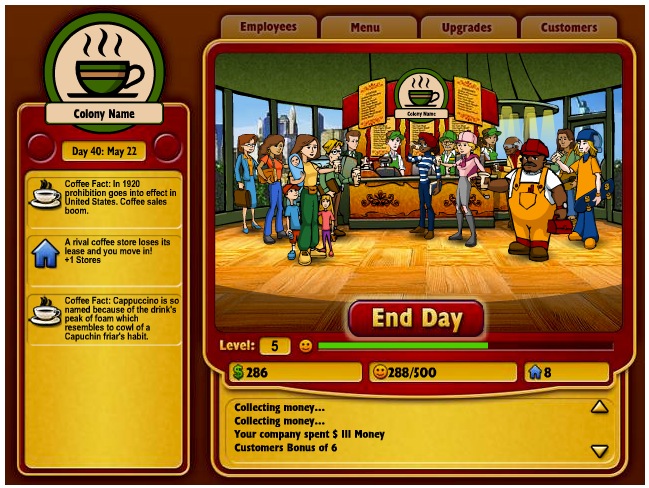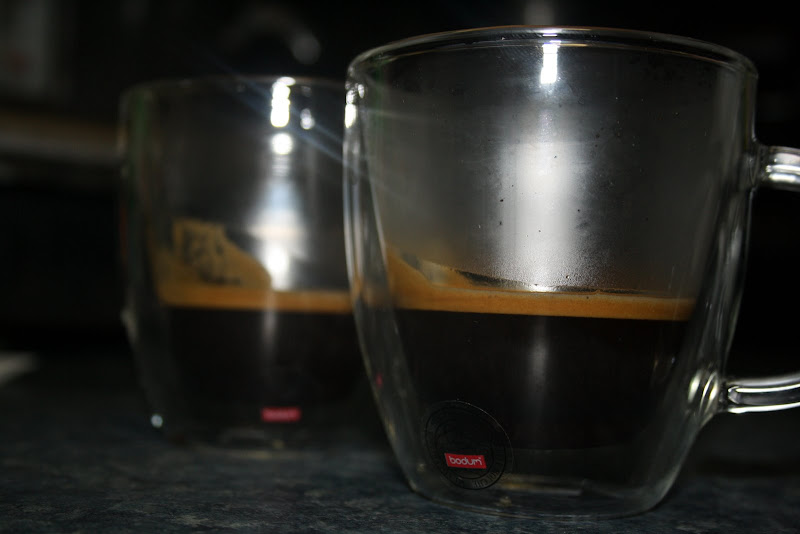I’m about to waste five minutes of your time. It’s no Farmville. But it’s your chance to set up your own coffee empire. In the spirit of every other tycoon game in the world comes Coffee Tycoon.

I’m about to waste five minutes of your time. It’s no Farmville. But it’s your chance to set up your own coffee empire. In the spirit of every other tycoon game in the world comes Coffee Tycoon.

Fairtrade is good. Direct trade is better. Fair trade sets a price for farmers above market value for farmers who agree to meet certain conditions (like paying their workers, joining a co-op set up, not using pesticides… etc). Direct trade is where coffee roasters strike deals with farms which ensure a quality income and quality output are much better for the farmer and the end user. You. The drinker.
Here’s a description of the issue Fairtrade aims to solve. A glut of producers have moved into the market and flooded the world with sub par coffee at cheap prices. Traditional coffee producers lose out, because coffee production is suddenly a worthwhile industry…
The problem is what is known as the international coffee crisis. Simply put, there’s too much cheap coffee flooding the market these days. It comes from countries such as Brazil and, more recently, Vietnam, which have been using massive agribusiness techniques. Record low coffee prices have devastated long-standing coffee producers such as Guatemala. Coffee was once the country’s No. 1 source of cash — now more money comes from emigrants sending money home from the United States.
Here’s what this situation means for coffee producers (from an article from 2003):
The coolest bit about this article is the little program that lets you decide how much money you think each entity in the coffee process should get from every coffee dollar you spend…
One of the things I’ve noticed in the course of my daily working life is that taking out the middle man is the new black. Direct distribution from wholesaler to purchaser is best. Taking out layers of middle men is preferable. Because producers and users get a better deal. I’ve noticed that a lot of printing companies that used to be niche printing companies are hiring designers and calling themselves one stop shops for design and printing. It makes sense. They get two bites of the cherry. They get their standard printing jobs from other designers while at the same time trying to undercut their design business…
It works for printing companies – it also works in coffee. Coffee roasters buying direct from growers is the best way forward for both quality of coffee and quality of life for those growing it.
Gizmodo celebrated some sort of food week last week. Some good stuff came out of it. Including this post on coffee. That was really good. Right up until the last heading. On espresso. The post covers the myriad brewing methods available and the range of costs involved. And then the writer shoots his credibility in the foot with this gem:
You know what? Let’s just get this out of the way: You can’t make amazing espresso at home. Not unless you’re will to spend something $US7500 on an espresso machine from someone like La Marzocco. Why? Consistency. Temperature. Pressure.
I call shenanigans. That is rubbish. Certainly a good machine in the hands of professionals is going to produce a better coffee than most people can do at home. But this is the biggest piece of rubbish I’ve ever seen. My machine was $450. It’s a machine in the class the guy mentions – but there are home machines in the prosumer/semi commercial capacity that would produce much better coffee than mine because they’re built with more control over those variables.
I’d also argue that getting the grind and the beans right is much more important than having the machine right – because at the end of the day all machines perform the same basic function – just with different abilities to control those variables.
I’m not going to completely discredit everything this turkey says on the basis of one error. Because the underlying principle, that a good cafe will make a better coffee than a good home set up, is true.
Fresh coffee is best. One of the factors involved in the freshness of coffee is carbon dioxide. Bookofjoe shared this great little tip from Cooks Illustrated.
“Freshness Test
To check if your beans are fresh, scoop 1/2 cup into a zipper-lock bag and press out all the air, then seal the bag and leave it overnight. If the beans are within seven to 10 days of roasting, they will make the bag puff up from the carbon dioxide that they release. If the bag remains flat, then the beans are not producing gas — a sign they’ve passed the point of peak freshness.”
And this graph…


Lifehacker posted a list of tips for getting a coffee on the cheap (mostly from Starbucks or other mega-chains).
But they had a couple of tips for those of us who know that the cheapest coffee is the coffee you do yourself at home. The more do it yourself the better…
I particularly liked this tip:
If you’re an iced coffee fan, but you hate how it gets watered down, you can make ice cubes out of black coffee and use them instead of ice.
Finding a good cafe when you’re on the road is pretty tough. We struggled in our January trip to New Zealand. There are a number of tips and tricks for checking if the cafe you’ve stopped in is worth your while. But most require you to actually step inside the cafe, and then there’s the awkward evacuation that comes after you spy the milk caked steam wand…

But no more. Beanhunter does the hard work for you. Tracking down independent cafes and recommending them. There’s one result for Townsville – the sadly defunct Squires (actually I think they’ve just moved, and I haven’t found them yet). I’ll put Coffee Dominion on the map. Because they deserve it.
In case I’ve not posted something like this before – here’s my fail safe list for judging a cafe without actually tasting their coffee…
The thing I dislike most about working in a temperature controlled (read air conditioned) office is that if I leave my cup of coffee on the desk it goes cold.
Clearly this little challenge has been occupying the minds of our best and brightest – because an inventor is proposing a system that will harness the power of mouse motion to heat coffee…

Brilliant.
For some reason there have been thousands (well tens) of great coffee tips around the Internet this week. I’m going to start posting them. There’ll be hundreds (well tens) of great coffee posts to follow.
I’m going to call it my international day of coffee posting. Let the calendars henceforth recognise this date as such.
So sit back, get yourself a cuppa, and have a read…
